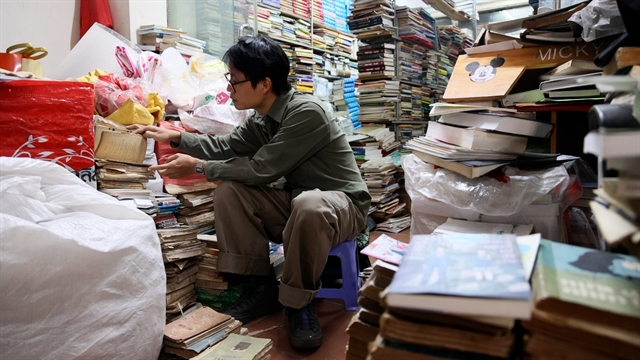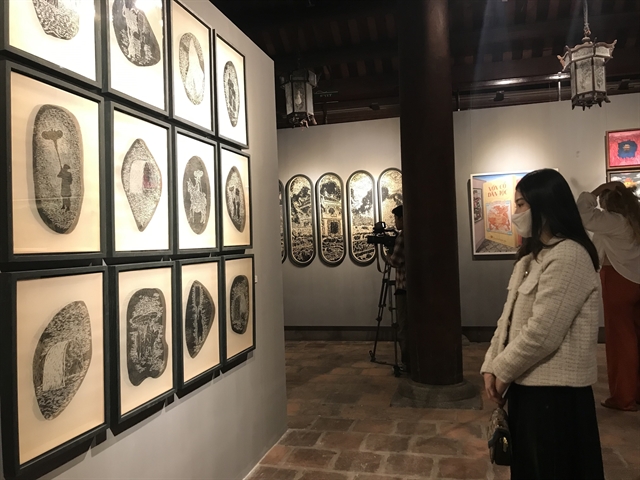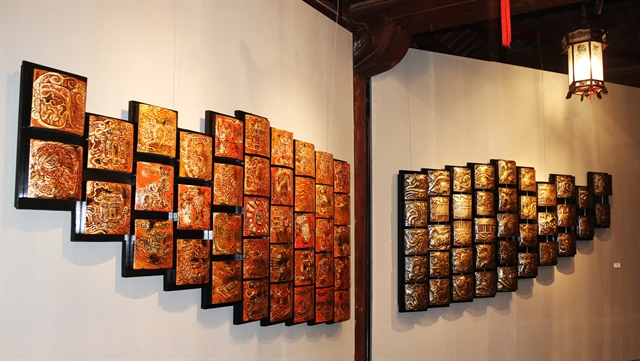 Life & Style
Life & Style

 |
| Visitors at the "Dấu xưa văn hiến" exhibition. VNA/VNS Photo |
HÀ NỘI — The Temple of Literature in Hà Nội is hosting an exhibition called "Dấu xưa văn hiến," which will provide visitors with a more sophisticated view of Việt Nam's rich cultural and historical heritage.
The Việt Nam National Institute of Culture and Arts and the Văn Miếu–Quốc Tử Giám Culture and Science Centre have collaborated to present this art exhibition, which features 19 works by eight artists who express Vietnamese cultural values in new and innovative ways through a wide range of compositional approaches, stylistic choices, and mediums.
An interactive pair of paintings by Vũ Xuân Đông titled "Cổ Thư" (Ancient Book) is made of bronze and lacquer.
By laying out the artwork like an open book, viewers are inspired to think back on cultural touchstones important to the Vietnamese people, such as buildings, sculptures, festivals, river life, and ancient patterns.
Đông explained that the inspiration for the piece came from the idea of an ancient book that told stories from the past.
 |
| Vũ Xuân Đông's "Cổ Thư" paintings are created on copper boxes and lacquer that interact with the viewers. Photo courtesy of vanmieu.gov.vn |
"My work is divided into curved boxes because those are pieces of memory," he described.
"And when people rotate these pieces of boxes, it will be like a river of culture, because on those boxes are the village gates, ancient boats, scenes of study and exams in the past, and the architecture of the front hall of the Temple of Literature," he said.
Three other extraordinary works by Nguyễn Đức Hùng, created with iron and smoke on traditional dó paper, provide rich and diverse aesthetic effects and open numerous bold and distinct ideas to viewers about the world.
Woodcarvings by Phạm Hùng Anh titled "Bóng nước" (Water Reflections) are also on display at the exhibition, offering a unique and personal take on the area of Khuê Văn Các.
According to Trần Thị Vân Anh, Deputy Director of the Hà Nội's Department of Culture and Sports, the city is the place where the country's cultural values are solidified, connected with studious piety and Việt Nam's first university (Quốc Tử Giám).
She believes that all of these fundamental ideals have become a great inspiration for artists who aspire to create works that breathe the breath of contemporary life while still bearing the imprints of the past.
It is also a trend that the Văn Miếu-Quốc Tử Giám is aiming for, becoming a centre of cultural activities, a creative space of Hà Nội city, a location to preserve and commemorate the country's cultural heritages in the most innovative and distinctive way, Anh noted.
Lê Xuân Kiêu, director of the Văn Miếu–Quốc Tử Giám Culture and Science Centre, the goal of the exhibition was to help the community, especially the younger generation, become more aware of the importance of preserving and promoting traditional cultural values through exposure to contemporary works of art that are composed on the basis of traditional culture.
Kiêu said: "Dấu xưa văn hiến, together with numerous other exhibitions and displays held at the Temple of Literature, will breathe new life into the relic site.
"That is the finest way to promote the significance of the monument, foster love and respect for the unique heritage that our forefathers have left us, and also demonstrate contemporary duty for future generations in continuing to add contemporary values to the country's cultural sedimentation."
The exhibition is open daily, from 8.00 am to 5.00 pm at the front house of Thái Học area, Văn Miếu-Quốc Tử Giám, until the end of February 5, 2023. VNS